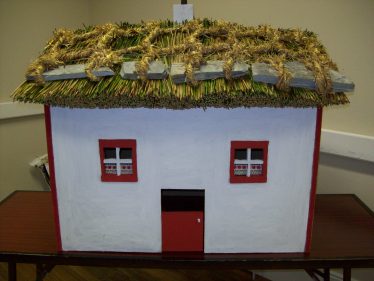
The steps involved in thatching a house were firstly to remove the old thatch, then rushes were layered onto the roof, súgáns put on vertically and finally súgáns put on horizontally (over and under the vertical ones) and muggled to tighten it. When we were growing up one of the main jobs in the month of September was to twist the súgáns for the house. All the houses in those days were all thatched. Depending on the length of the roof more hags were needed. Hags were balls of súgáns. Súgáns were ropes made from twisting straw or hay. The man demonstrating how to make a súgán said his own house would need twelve hags to thatch the roof.
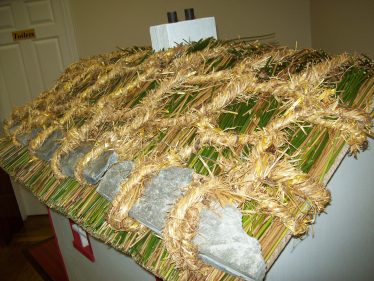
As kids growing up aged eleven or twelve years or younger, we spent a lot of the summer time making súgáns.
In the years gone by the houses wouldn’t be thatched until December because they were waiting for the oats to be harvested, the trashing was all done manually with flails which was a slow process. When the trashing machine came along the oats were harvested in September which meant thatching could be carried out earlier. Modernisation was slowly creeping in.
Preferably straw was used for súgáns; it was more pliable when it was chopped by thrasher rather than long uncut straw.
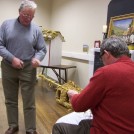
A child was useful to attach the rope around their waist and then one could start twisting the straw to make a rope. Or sometimes it was done by adults and late at night hence the saying “twisting by the moonlight”. You needed a fairly big area so the bigger the area the longer the rope. When the súgán was getting heavy and thickening, an upturned old cane chair (with the high legs) was used to take the load off. Or a barrel with a shovel stuck down in it would keep the súgáns against it.
The person that was twisting had to pace himself, keep a steady twist and also keep moving backwards, trying not to pull the other person out of the chair. The person sitting in the chair would usually be smoking a pipe as well as feeding the straw in. You would be waiting for him to fill the pipe so you could have a break.
The straw was hooked onto one end of the twister, and then more and more straw was added as you turned and turned the implement. The súgán would last roughly eleven months. If the house was thatched in the month of July, it would not need to be thatched again until the following July. Those súgáns withstood rain, storm, winter snow, the frosts and it was a hell of a job to pull them down again. Súgáns were also used to hold stacks of oats and barley in the harvest. It was the same with the reek of hay; all of these had to be súgáned, and done properly to withstand the severe storms. Today most people have sheds to store crops.
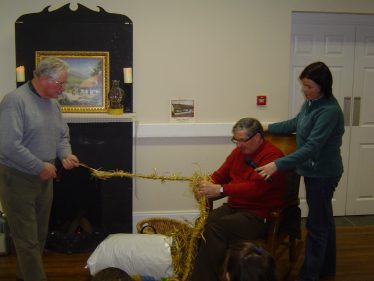
When the súgán was twisted, the person on the chair would roll it up into a ball (hag) on his knee and the twister would loosen the straw from the twister implement and break the end of it so that it could be knitted into another súgán. It was made into a hag so that the twists would stay in it and it was also easier to throw onto the roof.
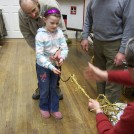
When the house was thatched it was always the job of a young fella to go up on the roof, he would be on his knees all evening. He had to catch the ball of twine or hag, which was fired up to him; the young fella had to hold the hag on the roof until he let it down on the other side. The east or west side, then it was thrown up again to him. That’s why we had great footballers in Mayo.
We used a 3×2 spar and you’d put down the súgán inside the spar, then turned it upside, cut it and you’d have two good súgáns then.
It was great fun and you’d be well fit for a good duck egg and a cup of tea and a piece of brown bread in the evening!
Up until fifty or sixty years ago in Killeen all the houses looked like the model. Houses were built using dry stone; the walls were two or three foot thick. Rushes were the raw material used to thatch houses. Rushes grow as weeds all around the area and they were used because they don’t absorb water, it just runs off them. Rushes grow in peaty soil, plenty around Killeen. Bent grew along the sea and was also used to thatch houses. It was like a strong grass, cut with a scythe and did the same job as rushes.
Rushes were layered on the roof and tied with anchors (local stones) and left along the bottom of the roof. Straw ropes (súgáns) were put across and muggled and tied down at the gables using pieces of iron which were stuck into the top of stones in the gables. “Muggled” is an Irish term and means to bring the whole rope together securely.
There were small windows and a half door. Everybody had hens, ducks and pigs and the half door would keep them out. In the time of landlords, rent was paid on the amount of light coming into the house.
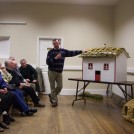
In the early 19th century the windows were just a square with timber across. There was no glass in them. Then the British government put a tax on the amount of light coming into a house through the windows and doors. The people rejected this and built smaller windows and a half door in their homes leading to the term “Daylight Robbery”.
In some houses before the glass was put into the windows, people had their own substitute. When a mare had a foal, the afterbirth was stretched and dried. Then this was put into the windows. It was transparent so it let the light in, but it was strong so it kept the wind and rain out.
Inside the door was a big kitchen, a room up to the left, with a second room up to the right. The fire place was really big, about five feet wide built with stone, and then it narrowed in as it went up to the top. All the cooking was done on the open fire. Pots and the kettle were hung on to crooks which were hung on the crane.
The Outshot, which was the master bedroom, was up close to the fire. It was also known as the hag or in Irish as the Cailleach. A little section was laid off to the side of the fireplace, where there was a small bed, usually for the husband and wife. Where there was an old couple living in the house, they would take the outshot when the young couple would move in. The old couple were close to the fire, and it was handy for everything.
Walking into a house, when you looked up all you would see was the scraws and some wooden beams. There was a timber roof made using bog deal or whatever came ashore. People went to the bog and cut a scraw which was about six inches off the top layer of bog, two foot or two foot square. The scraws were placed on top of the timbers first and then rushes were put on top of them. Over the years the rushes would build as only a few rushes were taken down to thatch the new roof.
The thatched houses were very warm in winter and yet in summer time it was lovely and cool. It was a very special job to thatch around the chimney; it had to be fastened properly so that no water would go down around the stones. Different materials were used to thatch in different areas of the country. Scallop thatch used straw instead of rushes, pegs and rods instead of súgáns. This was more common in Galway. Some thatched houses were thatched with flax. It was a beautiful roof. A fella that would get up in the morning at around 7 o’ clock, he would probably have the house thatched at around 3 or 4 o’ clock in the evening. For a summer’s day it was a good day’s work.
Usually about three men were enough to thatch a house, one man thatching, one man to tease out the rushes and one man to pass the bundles to the thatcher. The “hook” was also known as the “sickle”. Rushes were cut with this many years ago; it was also used to cut grass, corn and oats. It looked like a hand held piece of metal, shaped in a semi circle with the blade on the inside. The “scythe” (large blade attached to a handle with two small grip handles), was used to cut hay or oats. When it became available it was like a “four wheel drive”! An “edge” or a “scythe stone” was needed to sharpen the blade.
Soon some houses were being roofed using slate. Some houses used asbestos before adding slate. There was slate quarry in Feenone. As time went on and people had money, more slates were quarried and used on all newly built houses in the area. This work was all done by hand!
Modes of transport were horses and carts or donkey and carts or even donkey and cleaves.
The jobs you’d have to do as a young one! After school you would have to clean out barns, put in the fodder for the cattle, bring in water from the river and give the horse oats. You would have to bring in turf for the fire. Each one had their own little job to do. Lots of people have their own memories of living in thatched houses. Some remember the new slates coming from Feenone to replace the rushes on the roof. There were no computers or televisions or mod cons. It was not easy but it was mostly fun.
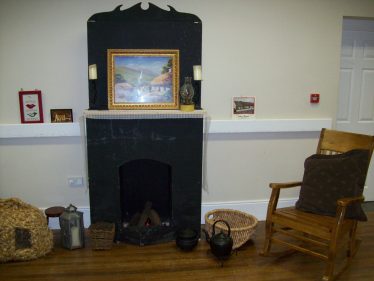
Most houses had an oil lamp. The wick was steeped in paraffin oil and lit. You’d get a clip on the ear if you broke the globe. Most people can remember their houses being connected to the electricity.
There was no running water in the house. A bucket of water from the well was used for the tea. River water was used for washing clothes with the wash board. In the summer time there was the job of tramping the blankets. Water was scarce so we’d go down to the nearest pond, fill big barrels with the pond water and then put down a big fire, heat the water and then put the blankets into the water. There were trampled on with your bare feet until they were clean.
There were three blacksmiths in the area: Joe Jennings, Johnny Fergus in Cahir and Mattie Sammin in Askillaun. The three men were very busy shoeing horses as the mare and cart were constantly working. They wear a lot of “sets of iron” in the year, and often an animal would slip a shoe, especially if she started galloping in the field. That mare had to be taken immediately to the blacksmith to replace the shoe. They also made many instruments for the kitchen, the tongs, and lids for pots, the grate for under the fire and they also made gates. The blacksmiths also had to turn a part for the scythe to attach the blade to the handle.

Pigs were a great source of food and everything was used from the pig except the squeal. We would buy a “banbh” (young pig) in the month of May and he was fed with all the offal from the house, like milk and potatoes. When the oats would come in the month of November, the pig would get some oats as this would sweeten the bacon. He would be killed usually in the first or second week of November. He was killed and water was boiled and poured over the pig to remove all the hair. Then it was left hanging for a full day usually on the back door of the house. Then he was cut up in chunks and put into a barrel. The chunks were layered in the barrel with coarse salt and a little grain of sugar. This was left for three weeks and the salt would turn into “pestle” and it would be running out the bottom of the timber barrel. Then the pieces were taken out and hung along the ceilings and left until it was needed. Nothing was ever wasted from the pig, even the blood was used in black pudding. Eight people would play a card game for the pig’s head. Each person had to pay a half a crown to play. Whoever won the pig’s head could make “range” from it. A hen or a chicken was boiled in a pot with the pig’s head, this made the meat delicious and it fell off the bone. Someone remembers paying sixpence for a pig’s tail in Huddersfield, England.
There were shops in every village one time. The following are some that people remember:
• James O’Malley, his father and his grandfather in Furmoyle
• Tommy Joe O’Malley in Sixnoggins
• Bernie Coyne in Killadoon
• Austin Mc Namara in Devlin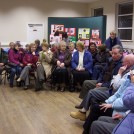
• Paddy Jordan’s in Feenone
• Morrison’s in Killadoon
• Anthony O’Malley in Doughmakeon
• Joe Gibbons and Maggie Donnelly’s in Carrowniskey
• Shop in Cregganbawn
• Shop in Pat Keane’s Aillemore.
• Meat shop beside the church, Johnny Gibbons ran it on a
Sunday and he also sold the Sunday papers.
Austin Francis O’Malley had a travelling shop and he sold everything from an anchor to a needle. Even though people had no money the shop stayed open. The most items people bought were sugar, tea and oil for the lamp. You could get a pound of sodium for four pence and a packet of Saxa salt for six pence. Every house had hens, ducks and geese and as a young one you would be sent off to the shop with the eggs. You got tea, sugar and if the man of the house smoked, you would get tobacco in return for the eggs. A half quarter of eggs was fifteen eggs, and a quarter of eggs were thirty eggs. There is a lovely story about a boy who was sent down to the shop with a basket of eggs. The poor devil tripped and broke all the eggs. He put a proposition to the shopkeeper. He would gather the eggs one by one unknown to them in the house, until he had all the eggs for the shopkeeper inside the month. The shopkeeper went along with it, gave him the shopping, and he had given her all the eggs within the month.
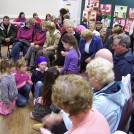
During the war everybody had ration books and coupons, a certain amount per person. That’s how the food was rationed. The coupons had to be taken out every month. You would take the book to the shopkeeper and he would tell you the amount of coupons you were entitled to. And you would get that amount of food then. When you had used all your coupons you wouldn’t get any food. Tea, sugar and flour were rationed.
Where there were lots of men in one house, they could be very severe on flour. As children got the same amount of rationing as adults, there might be a surplus of coupons left over. As neighbours and friends, they might give the surplus to people who were more in need. The tea ration was very severe on the old people who loved the cup of tea.
A man used to go visiting three older men who smoked pipes. They would ask him for an ounce of tobacco. Not even a plug they wanted just half an ounce. He would be the man “rallied” off with the half ounce the next day. It was better than winning the lotto, but didn’t last them long.
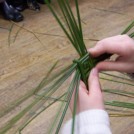 *
*
In 1947 Eileen Ferrins came to Furmoyle from Armagh. She was making St. Brigid’s crosses and was noticed by John Gibbons (Pat Ned) who was the postman at that time. He was interested in finding out how the cross was made. Eileen taught him how to make it and he then passed on that skill to other people in the area.






No Comments
Add a comment about this page